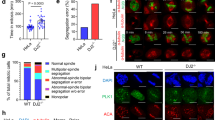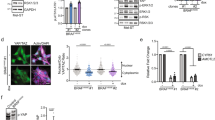Abstract
Molecular therapeutics is a recognized promising approach for melanoma, but relevant target genes remain elusive. We report that overload of the recently cloned H11/HspB8 induces apoptosis in 55% of examined melanoma cultures. Apoptosis was determined by activation of caspases-9 and -3 and terminal deoxynucleotidyltransferase-mediated dUTP nick end labeling (TUNEL), and was not seen in normal melanocytes. It was associated with H11/HspB8 complexation with transforming growth factor-β-activated kinase (TAK) 1 and activation of TAK1 and p38 mitogen activated protein 3 kinases. TAK1 was not bound, nor activated by the H11/HspB8 mutant W51C, which has dominant antiapoptotic activity. β-Catenin was phosphorylated by activated TAK1, inhibiting its nuclear accumulation and mictophthalmia-associated transcription factor and cyclin dependent kinase 2 expression. The dominant-negative TAK1 mutant K63W inhibited β-catenin phosphorylation and caspase activation. The data indicate that H11/HspB8 overload causes melanoma growth arrest and apoptosis through TAK1 activation and suggest that H11/HspB8 is a promising molecular therapy target.
This is a preview of subscription content, access via your institution
Access options
Subscribe to this journal
Receive 50 print issues and online access
$259.00 per year
only $5.18 per issue
Buy this article
- Purchase on Springer Link
- Instant access to full article PDF
Prices may be subject to local taxes which are calculated during checkout











Similar content being viewed by others
References
Aurelian L . (2005). HSV-induced apoptosis in herpes encephalitis. Curr Top Microbiol Immunol 289: 11–79.
Chabaud S, Lambert H, Sasseville AM, Lavoie H, Guilbault C, Massie B et al. (2003). The R1 subunit of herpes simplex virus ribonucleotide reductase has chaperone-like activity similar to Hsp 27. FEBS Lett 545: 213–218.
Chae HD, Yun J, Bang YJ, Shin DY . (2004). Cdk2-dependenet phosphorylation of the NF-Y transcription factor is essential for the expression of the cell cycle-regulatory genes and cell cycle G1/S and G2/M transitions. Oncogene 23: 4084–4088.
Chowdary TK, Raman B, Ramakrishna T, Rao CM . (2004). Mammalian Hsp-22 is a heat-inducible small heat-shock protein with chaperone-like activity. Biochem J 381: 379–387.
Ciocca DR, Calderwood SK . (2005). Heat shock proteins in cancer: diagnostic, prognostic, predictive, and treatment implications. Cell Stress Chaperones 10: 86–103.
Cox AD, Der CJ . (2003). The dark side of Ras: regulation of apoptosis. Oncogene 22: 8999–9006.
Davis RJ . (2000). Signal transduction by the JNK group of MAP kinases. Cell 103: 239–252.
Diao L, Zhang B, Xuan C, Sun S, Yang K, Tang Y et al. (2005). Activation of c-Jun N-terminal kinase (JNK) pathway by HSV-1 immediate early protein ICP0. Exp Cell Res 308: 196–210.
Du J, Widlund HR, Horstmann MA, Ramaswamy S, Ross K, Huber WE et al. (2004). Critical role of CDK2 for melanoma growth linked to its melanocyte-specific transcriptional regulation by MITF. Cancer Cell 6: 565–576.
Edlund S, Bu S, Schuster N, Aspenstrom P, Heuchel R, Heldin NE et al. (2003). Transforming growth factor-beta1 (TGF-beta)-induced apoptosis of prostate cancer cells involves Smad7-dependent activation of p38 by TGF-beta-activated kinase 1 and mitogen-activated protein kinase kinase 3. Mol Biol Cell 14: 529–544.
Fink D, Schlagbauer-Wadl H, Selzer E, Lucas T, Wolff K, Pehamberger H et al. (2001). Elevated procaspase levels in human melanoma. Melanoma Res 11: 385–393.
Furuta J, Umebayashi Y, Miyamoto K, Kikuchi K, Otsuka F, Sugimura T et al. (2004). Promoter methylation profiling of 30 genes in human malignant melanoma. Cancer Sci 95: 962–968.
Gallagher WM, Bergin OE, Rafferty M, Kelly ZD, Nolan IM, Fox EJ et al. (2005). Multiple markers for melanoma progression regulated by DNA methylation: insights from transcriptomic studies. Carcinogenesis 26: 1856–1867.
Gober MD, Smith CC, Ueda K, Toretsky JA, Aurelian L . (2003). Forced expression of the H11 heat shock protein can be regulated by DNA methylation and trigger apoptosis in human cells. J Biol Chem 278: 37600–37609.
Gober MD, Wales SQ, Aurelian L . (2005). Herpes simplex virus type 2 encodes a heat shock protein homologue with apoptosis regulatory functions. Frontiers Biosci 10: 2788–2803.
Hase M, Depre C, Vatner SF, Sadoshima J . (2005). H11 has dose-dependent and dual hypertrophic and proapoptotic functions in cardiac myocytes. Biochem J 388: 475–483.
Ishitani T, Ninomiya-Tsuji J, Nagai S, Nishita M, Meneghini M, Barker N et al. (1999). The TAK1-NLK-MAPK-related pathway antagonizes signaling between beta-catenin and transcription factor TCF. Nature 399: 798–802.
Ivanov VN, Fodstad O, Ronai Z . (2001). Expression of ring finger-deleted TRAF2 sensitizes metastatic melanoma cells to apoptosis via up-regulation of p38, TNFalpha, and suppression of NF-kappaB activities. Oncogene 20: 2243–2253.
Karpf AR, Lasek AW, Ririe TO, Hanks AN, Grossman D, Jones DA . (2004). Limited gene activation in tumor and normal epithelial cells treated with the DNA methyltransferase inhibitor 5-aza-2′deoxycytidine. Mol Pharmacol 65: 18–27.
Kishimoto K, Matsumoto K, Ninomiya-Tsuji J . (2000). TAK1 mitogen-activated protein kinase kinase kinase is activated by autophosphorylation within its activation loop. J Biol Chem 275: 7359–7364.
Margolin KA . (2004). Biochemotherapy for melanoma: rational therapeutics in the search for weapons of melanoma destruction. Cancer 101: 435–438.
Park CS, Kim SI, Lee MS, Youn CY, Kim DJ, Jho EH et al. (2004). Modulation of beta- catenin phosphorylation/degradation by cyclin-dependent kinase 2. J Biol Chem 279: 19592–19599.
Perez-Stable C . (2006). 2-methoxyestradiol and paclitaxel have similar effects on the cell cycle and induction of apoptosis in prostate cancer cells. Cancer Lett 231: 49–64.
Reu FJ, Leaman DW, Maitra RR, Bae SI, Cherkassky L, Fox MW et al. (2006). Expression of RASSF1A, an epigenetically silenced tumor suppressor, overcomes resistance to apoptosis induction by interferons. Cancer Res 66: 2785–2793.
Saito H, Yasumoto K, Takeda K, Takahashi K, Yamamoto H, Shibahara S . (2003). Microphthalmia-associated transcription factor in the Wnt signaling pathway. Pigment Cell Res 16: 261–265.
Sharma BK, Smith CC, Laing JM, Rucker DA, Burnett JW, Aurelian L . (2006). Aberrrant DNA methylation silences the novel heat shock protein H11 in melanoma but not benign melanocytic lesions. Dermatology 213: 192–199.
Singhirunnusorn P, Suzuki S, Kawasaki N, Saiki I, Sakurai H . (2005). Critical roles of threonine-187 phosphorylation in cellular stress-induced rapid and transient activation of TAK1 in a signaling complex containing TAB1 and TAB2. J Biol Chem 280: 7359–7368.
Smith CC, Yu YX, Kulka M, Aurelian L . (2000). A novel human gene similar to the protein kinase (PK) coding domain of the large subunit of herpes simplex virus type 2 ribonucleotide reductase (ICP10) codes for a serine–threonine PK and is expressed in melanoma cells. J Biol Chem 275: 25690–25699.
Soengas MS, Capodieci P, Polsky D, Mora J, Esteller M, Opitz-Araya X et al. (2001). Inactivation of the apoptosis effector Apaf-1 in malignant melanoma. Nature 409: 207–211.
Sun X, Fontaine JM, Rest JS, Shelden EA, Welsh MJ, Benndorf R . (2004). Interaction of human HSP22 (HSPB8) with other small heat shock proteins. J Biol Chem 279: 2394–2402.
Tsao H, Sober AJ . (2005). Melanoma treatment update. Dermatol Clin 23: 323–333.
van der Velden PA, Zuidervaart W, Hurks MH, Pavey S, Ksander BR, Krijgsman E et al. (2003). Expression profiling reveals that methylation of TIMP3 is involved in uveal melanoma development. Int J Cancer 106: 472–479.
Wakefield LM, Roberts AB . (2002). TGF-beta signaling: positive and negative effects on tumorigenesis. Curr Opin Genet Dev 12: 22–29.
Wang TH, Chan YH, Chen CW, Kung WH, Lee YS, Wang ST et al. (2006). Paclitaxel (Taxol) upregulates expression of functional interleukin-6 in human ovarian cancer cells through multiple signaling pathways. Oncogene 25: 4857–4866.
Widlund HR, Horstmann MA, Price ER, Cui J, Lessnick SL, Wu M et al. (2002). Catenin-induced melanoma growth requires the downstream target microphthalmia-associated transcription factor. J Cell Biol 158: 1079–1087.
Yu R, Chen C, Mo YY, Hebbar V, Owuor ED, Tan TH et al. (2000). Activation of mitogen-activated protein kinase pathways induces antioxidant response element-mediated gene expression via a Nrf2-dependent mechanism. J Biol Chem 275: 39907–39913.
Zendman AJ, van Kraats AA, den Hollander AI, Weidle UH, Ruiter DJ, van Muijen GN . (2002). Characterization of XAGE-1b, a short major transcript of cancer/testis-associated gene XAGE-1, induced in melanoma metastasis. Int J Cancer 97: 195–204.
Acknowledgements
Supported in part by grant AR42647 from NIAMD, NIH. BL, JML and MDG were supported by grant ES07263 from NIEHS, NIH.
Author information
Authors and Affiliations
Corresponding author
Additional information
Supplementary Information accompanies the paper on the Oncogene website (http://www.nature.com/onc).
Rights and permissions
About this article
Cite this article
Li, B., Smith, C., Laing, J. et al. Overload of the heat-shock protein H11/HspB8 triggers melanoma cell apoptosis through activation of transforming growth factor-β-activated kinase 1. Oncogene 26, 3521–3531 (2007). https://doi.org/10.1038/sj.onc.1210145
Received:
Revised:
Accepted:
Published:
Issue Date:
DOI: https://doi.org/10.1038/sj.onc.1210145
Keywords
This article is cited by
-
The Homeobox gene, HOXB13, Regulates a Mitotic Protein-Kinase Interaction Network in Metastatic Prostate Cancers
Scientific Reports (2019)
-
Aberrant DNA methylation in melanoma: biomarker and therapeutic opportunities
Clinical Epigenetics (2017)
-
Effects of High Hydrostatic Pressure on Expression Profiles of In Vitro Produced Vitrified Bovine Blastocysts
Scientific Reports (2016)
-
Genetic parameters and genome-wide association study of hyperpigmentation of the visceral peritoneum in chickens
BMC Genomics (2013)
-
Restored expression of the atypical heat shock protein H11/HspB8 inhibits the growth of genetically diverse melanoma tumors through activation of novel TAK1-dependent death pathways
Cell Death & Disease (2012)



